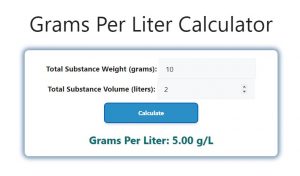About Grams Per Liter Calculator (Formula)
The Grams Per Liter (GPL) Calculator is a practical tool for scientists, students, and anyone working with solutions in various fields, including chemistry, biology, and environmental science. It allows users to determine the concentration of a solute in a solution, which is essential for preparing accurate chemical mixtures, conducting experiments, and analyzing results. Understanding the concentration of solutions is vital for ensuring proper reactions, achieving desired outcomes, and maintaining safety in laboratory settings.
Formula
The formula to calculate grams per liter is: GPL = W / V, where GPL represents grams per liter, W is the mass of the solute in grams, and V is the volume of the solution in liters.
How to Use
Using the Grams Per Liter Calculator is simple. Follow these steps:
- Measure the Mass of the Solute (W): Weigh the solute you are dissolving to get its mass in grams.
- Determine the Volume of the Solution (V): Measure the total volume of the solution, typically in liters.
- Input the Values: Enter the mass of the solute and the volume of the solution into the calculator.
- Calculate Grams Per Liter (GPL): The calculator will compute the grams per liter concentration based on your inputs.
Example
Let’s consider an example where the mass of the solute is 10 grams, and the volume of the solution is 2 liters.
- Mass of Solute (W): 10 g
- Volume of Solution (V): 2 L
Using the formula:
GPL = W / V
Calculating gives:
GPL = 10 g / 2 L
GPL = 5 g/L
Thus, the concentration of the solution is 5 grams per liter.

FAQs
- What is grams per liter (GPL)? GPL is a unit of concentration that indicates how many grams of solute are present in one liter of solution.
- Why is measuring concentration important? Understanding concentration is crucial for chemical reactions, preparing solutions, and ensuring accurate results in experiments.
- How do I convert grams per liter to other concentration units? You can convert GPL to moles per liter (M) by dividing the grams per liter by the molar mass of the solute.
- Can I use this calculator for different types of solutes? Yes, the calculator can be used for any solute as long as you know its mass and the volume of the solution.
- What happens if I dilute a solution? Diluting a solution decreases its concentration, resulting in a lower grams per liter value.
- How do temperature and pressure affect concentration? Changes in temperature and pressure can affect the solubility of a solute and the volume of a solution, impacting its concentration.
- What is the difference between weight/volume and grams per liter? Weight/volume percentage is the mass of solute per volume of solution expressed as a percentage, while grams per liter is the absolute mass per liter.
- How can I prepare a specific concentration solution? Use the GPL formula to determine the required mass of solute for a given volume to achieve your desired concentration.
- What instruments do I need to measure mass and volume? A balance is used to measure mass, while a graduated cylinder or volumetric flask is used to measure volume.
- Can I use the calculator for solid, liquid, and gas solutes? Yes, the calculator can be applied to any solute, but ensure the solute is soluble in the chosen solvent.
- How do I find the molar mass of a solute? Molar mass can be found on the periodic table or in chemical databases for pure substances.
- What is the significance of knowing the concentration in environmental science? Concentration data helps assess pollutant levels, nutrient availability, and chemical reactions in ecosystems.
- How do I handle concentrated solutions safely? Always use appropriate personal protective equipment (PPE) and follow safety guidelines when handling concentrated solutions.
- What factors can lead to errors in concentration measurements? Errors can arise from inaccurate mass measurements, incorrect volume readings, and impurities in the solute.
- How does concentration affect reaction rates? Generally, higher concentrations lead to increased reaction rates due to more frequent collisions between reactant molecules.
- What is the role of dilution in laboratory procedures? Dilution is often used to achieve the desired concentration for experiments, making solutions safer and more manageable.
- Can I calculate grams per liter for complex mixtures? Yes, you can calculate the concentration for each solute in a mixture individually if you know their masses and the total volume.
- How do I interpret the results of the GPL calculator? The result indicates the concentration of the solute, which helps in determining if it meets the requirements for your application.
- What resources can I use to learn more about solution chemistry? Chemistry textbooks, online courses, and academic journals provide in-depth information on solution chemistry and concentration calculations.
- Can this calculator assist with quality control in manufacturing? Yes, maintaining consistent concentrations is critical for quality control in chemical manufacturing and pharmaceuticals.
Conclusion
The Grams Per Liter Calculator is an essential tool for anyone working with solutions in scientific and industrial settings. By providing a straightforward method to calculate the concentration of a solute in a solution, this calculator enhances understanding and accuracy in experiments and processes. Whether you are a student, researcher, or professional, utilizing this calculator can lead to better results and informed decision-making in various applications, from chemistry labs to environmental analysis.
